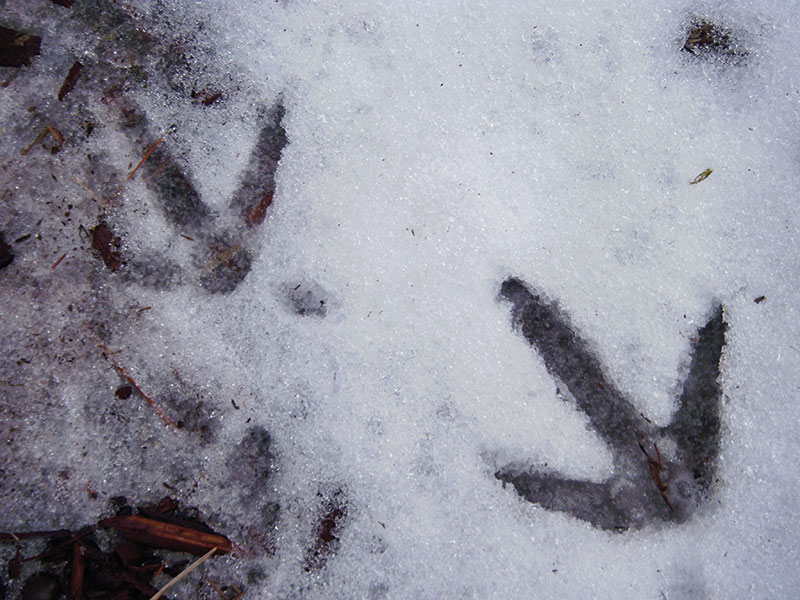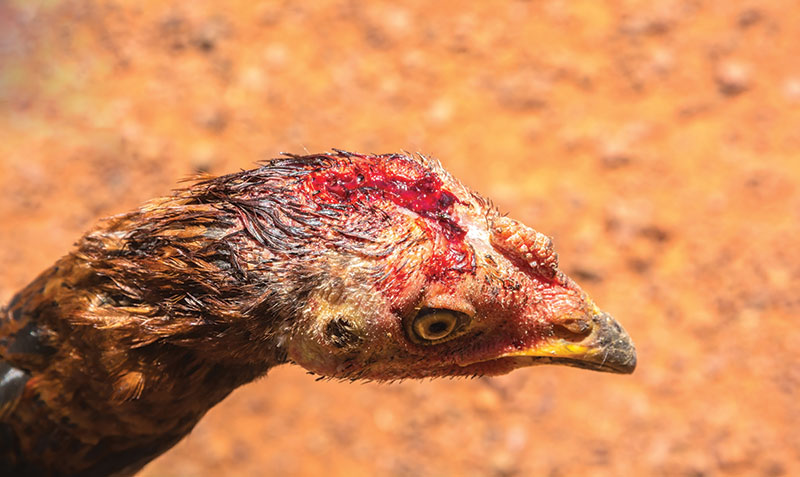
What do fleas, flies and feathers have in common? They love their poultry hosts. In this installment, we look at some bugs that can bother our feathered friends and what we can do about them. We also cover the dangers of winter and the risk of frostbite, the importance of housing for health and what to keep in your chicken first-aid kit. Here we cover the letters F through I. Let’s start with feathers. (Read the other installments of the series here: Part 1, Part 2, Part 4, Part 5, Part 6.)
Feathers
Your chicken’s feathers are her home. They protect her skin and keep her insulated against cold; feather health is a direct reflection of a chicken’s overall health. A healthy chicken’s feathers are smooth and glossy, bright and colorful.
Feather health is important to the chicken keeper, too. A bird’s feathers and the feathers’ appearance are often a first indicator of illness, disease or injury. How many times have you noticed something amiss by the look of a hen’s feathers?
Chickens naturally lose their feathers once per year during the annual molt. It’s easy to mistake this natural process as a sign of ill health. Look closely at your bird’s behavior and determine whether there are other symptoms before panicking. That said, feather loss (aside from the yearly molt) is reason to pay close attention. Roosters often wear down bald patches on a hen’s back from mating; feather picking is a cannibalistic activity that can be evidence of severe bullying; and many species of louse prefer the feathers as a home.
The good news is that you needn’t do anything special to care for your bird’s feathers. She’ll take care of that on her own. Your job is providing the opportunities for her to do what she needs.
Each healthy bird is responsible for her own grooming and feather health. After a thorough dust bath, the chicken finds a place to perch and preens herself from head to shank. Sourcing a special feather oil from her preen gland, located at the base of her tail, each chicken uses her beak to distribute the oil throughout her feathers. Your job is to provide adequate dust-bathing materials—such as loose soil, mulch, sand or other dry, loose material—and a place to perch. She’ll do the rest.
Chickens keep their feathers clean by dust bathing. This is the act of rolling or moving around in dirt to cleanse the skin and feathers of parasites, dead skin and other irritants. “It also helps prevent the buildup of the oil from preening,” writes Jacquie Jacob, poultry extension project manager at the University of Kentucky in “Normal Behaviors of Chickens in Small and Backyard Poultry Flocks.” “When chickens do not have access to dust baths, they will nonetheless go through the motions of dust bathing. In behavioral studies, hens have shown a willingness to work to gain access to material for dust bathing.”
Fleas & Flies

Fleas and flies are insects that feed on the blood of chickens and live off the body to breed and perpetuate their life cycles. The European chick flea (Ceratophyllus gallinae) and the western hen flea (Ceratophyllus niger) are the two species most likely to affect North American flocks. Both flea types breed in nests, bedding and droppings, and they return to the birds for blood meals.
Black flies and biting flies are larger insects found near stagnant water. Filth flies breed in soggy manure and damp bedding.
What’s the harm in a flea or fly, you wonder? Well, an infestation of either insect can lead to weight loss or slow growth in young birds as well as physical damage to meat birds, and it might affect egg production in laying hens. Heavy infestations of fleas or flies can severely weaken chicks and sick birds, perhaps resulting in death. These insects can also, of course, carry and spread disease from one bird to another.
Because populations of these two insects are supported by damp conditions, keep bedding, nest boxes and litter dry. Check faucets, waterers and roofs for leaks, and remove all sources of stagnant water. To control flies, clean the coop thoroughly after removing the litter and replacing with fresh bedding. Improve ventilation on very hot days especially, because flies don’t like moving air. Flytraps hung out of reach of the chickens as well as other commercially available fly-control products can help you control the fly population.
The most effective way to control flies is by manure management. “As many as 1,000 house flies can complete development in 1 pound of breeding material,” note extension specialists Jeffery Tomberlin and Bart Drees in “Poultry Pest Management” written for Texas A&M Agrilife Extension. “Fresh poultry manure contains 75 to 80 percent moisture, which makes it ideal for fly breeding. You can practically eliminate fly breeding in this material by reducing the moisture content to 30 percent or less. Drying manure is preferred because once dried, it will occupy less space, usually has less odor and is more easily transported off site. Also, high-moisture manure often results in high black garbage fly populations.”
Frostbite

In winter, a hen sleeps with her head tucked under a wing; a rooster does not. In biting cold temperatures, roosters’ extra large combs are exposed to the extremes, putting them at risk. When frozen, a comb or wattle will appear pale. If you can catch this at the frozen stage, apply a warm, wet cloth; allow it to dry; and then apply food-grade oil. If it has frozen and already thawed, you might notice it’s bright red and swollen. It might appear painful. At this stage, you can still apply food-grade oil or honey on the appendage to promote healing.
Serious cases of frostbite can leave a rooster permanently ill or even infertile. If you suspect frostbite or serious freezing, watch the rooster carefully, as his injury could weaken him, which can leave him susceptible to pecking from the rest of the flock. If necessary, isolate an injured bird for care. If the wattle or comb turn black and the tissue is dead, it might need to be surgically removed.
There isn’t one easy way to prevent frostbite, but you can take several measures to help. For this and many other reasons, make sure your coop is properly insulated but also has excellent ventilation. Monitor chickens closely during the winter, and make sure they always have fresh water.
In cold weather, check birds daily for signs of frostbite. “Before giving frostbite an opportunity to stress and damage your birds, apply a thick layer of [petroleum jelly] to the entire surface of combs and wattles,” says Brigid McCrea, poultry specialist at Delaware State University, in “The Basics of: Winterizing Your Coop.”
Housing

While they’re scrappy and tenacious in general, chickens are most vulnerable at night. Their night vision is poor, and their defenses are minimal. Their best defense against the predators of the night and cold during winter is a proper shelter.
As a chicken keeper, this is where you come in. Build a coop for chickens that is secure from predators: It should be free of gaps and drafts. The roof should be secure. Hardware cloth mesh is best to line all of the windows and doors, with secure latches on all of the doors and nest boxes. As mentioned previously, provide excellent ventilation but keep the coop free from drafts. For laying flocks, provide one nest box for every four to five hens; smooth but sturdy roosts that are higher than the nest boxes; and dry, safe bedding material—such as hay or pine shavings—on the floor and in the nest boxes.
Housing is an important topic in the world of keeping chickens. Remember that your coop is the home base for your birds: They will come back to it each night at dusk and rely on its walls for their very safety.
“For backyard chicken-keeping, you can have a variety of different setups, each with its own advantages and disadvantages,” write Kevin McElroy and Matthew Wolpe in Reinventing the Chicken Coop. “Deciding which setup is right for you involves many considerations, such as the amount of available space, local zoning ordinances, weather, the number of chickens you’d like to keep and how much time you want to spend on maintenance.”
Injury

A tussle with another bird, a run-in with a predator, a snag on a loose piece of wire—at any time in the life of a flock, an injury might occur. And just like with our own bodily needs, it helps to have a working, fully stocked first-aid kit at the ready for the little injuries.
Here are a few items to keep on hand for a chicken emergency:
- isolated housing (to reduce the risk of cannibalism against the injured bird)
- disposable gloves, for when you need to be hands-on
- antiseptic spray
- a self-adhesive gauge that won’t stick to feathers
- hemorrhoid cream, for treating an egg-bound hen
- saline solution for eye wounds
- VetRx for Poultry (relief and treatment for respiratory issues)
- cornstarch, a natural product to stop bleeding
- cocoa, shea or mango butter, or a food-grade oil, for preventing frostbite
Treat open wounds by clipping feathers away from the edges of the wound, suggests author and chicken keeper Christine Heinrichs in How to Raise Poultry. “Wash with clean water and apply antibiotic ointment twice daily,” she writes. “Dust or spray insecticide around wounds to prevent maggots.”
Keeping chickens is engaging—the birds always keep us on our toes. This is especially true when they’re sick, injured or playing host to hundreds of creepy crawlies. Some coop maintenance and a little diligence in cleaning goes a long way toward preventing pests and injuries, keeping your birds healthy and making sure their feathers shine brightly.
This story originally appeared in the May/June 2018 issue of Chickens magazine.




